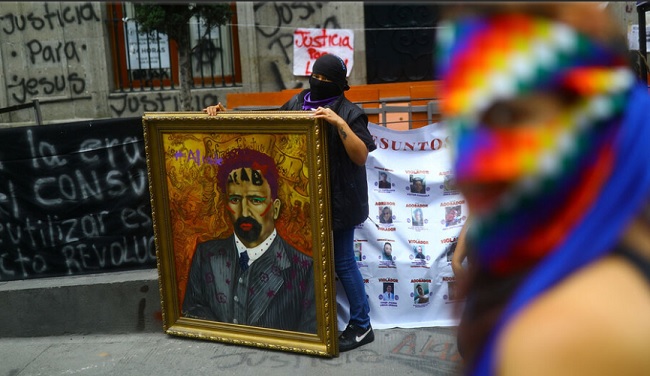Scrawled on a formerly white wall inside the National Commission for Human Rights (CNDH) offices in Mexico City is the image of a woman in a purple dress leaning over the spitting flames of an orange and red fire. A number of conversation bubbles surround the painting, but only one is colored in to make the words pop:
“To build,” it reads, “you have to destroy.”
The phrase was painted by a group of feminists who gained international attention this fall when they took over the government building, demanding better protection for women and girls in Mexico. Groups of mothers, victims, and activists took over a handful of human rights offices across the country in September, building on years of mounting outrage. But attention to their cause is increasingly focused on whether the women are fighting for change the “right” way – echoing rhetoric that has swirled around racial justice protests in the United States, as well as other feminist movements around the world in recent years.
In Mexico City, site of the first occupation, government workers were kicked out of the CNDH building two days after the mother of a young rape victim tied herself to a chair to protest inaction around her daughter’s case. Portraits of historical figures were turned upside down or given new looks via the addition of green eyeshadow or devil horns. Walls were painted over with feminist slogans, like “not one less” and “we want them alive.” The building was converted into a women’s shelter, with some 40 women and children currently living there.
The CNDH protests are the latest in a series of increasingly loud calls for the government to better protect women in a nation where femicides have doubled during the past five years. An estimated 10 women are murdered each day in Mexico, according to state statistics. With university students protesting sexual assault at the hands of faculty members, so-called glitter protests launched by covering the capital’s security chief with pink glitter, the historic turnout for Women’s Day marches last spring, and a national women’s strike the following day, momentum has grown here in recent years.
But Mexicans across social media – and the president – are questioning protest strategies, asking how taking over buildings and painting over portraits are necessary to guarantee safety for women. The more radical approach to calling attention to violence against women has sparked debates over what makes a “real” feminist, and has some arguing that it distracts from the broader goal of a more peaceful, safer nation for women.
“The indignation is the same; what’s changing are the strategies,” says Daniela Cerva, a sociologist at the Autonomous University of Morelos State, who studies feminist movements in Mexican universities. “Before women sat and asked for a meeting, or went out with their signs and sang or yelled.” Now, they’re taking over buildings, carrying out art interventions, or choreographing mass performance pieces.
Click here for full article by Whitney Eulich on CSMonitor.com



